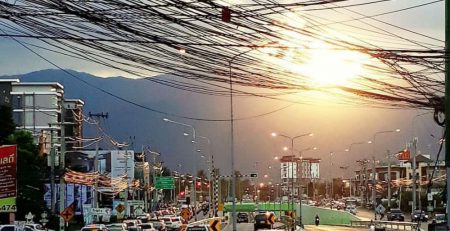Jio sends shock waves across the telecom industry with new FTTH broadband service and JioPhone exchange offer
The recently concluded Annual General Meeting (AGM)1 of Reliance Industries is sure to leave Reliance Jio’s competitors in jitters, as Jio unveiled plans to roll out optical fiber to the home (FTTH) across 1,100 cities in India. Its commercial launch is planned for December 2018. At the same meeting, Jio announced a JioPhone handset offering which will be a major threat to many small handset manufacturers.
Despite not being currently active in the fixed broadband market, JioFiber will benefit from Jio’s wireless internet market share (ranked #1 as per TRAI based on subscriber base) 2. Jio’s recent acquisition of distressed carrier Reliance Communications is also a plus. However, Jio will face hurdles initially given the challenges of underground fiber installation.
Jio hopes to replicate its wireless success with GigaFiber
After growing from zero to 215 million wireless users in just 22 months on its new 4G network, Jio already has everyone’s eyebrows raised. Jio has now shifted its focus towards its FTTH broadband service via ‘Jio GigaFiber’. The fiber service includes Jio Giga TV, smart home accessories and a landline connection. Jio’s FTTH rollout could kickstart the local broadband market, where penetration is low. TRAI’s March 2018 data estimates that India had only 21.2 million fixed broadband internet users – as against 472.7 million mobile data users.
While Jio is new to the fixed market, Jio has been installing fiber aggressively for the last 4 years. Its fiber optic network now spans over 300,000 kms. That includes metro and access fiber designed to support an eventual FTTH offering. This should allow Jio to differentiate from other Indian operators, which tend to provide fiber optic cables only to the building, and use a variety of technologies for customer access (VDSL, Ethernet, WiFi etc). Jio’s fiber will instead be connected directly to the user’s CPE. Jio does have competition, though. Airtel launched its vectorization-based service, V-Fiber3, in Pune in late 2016. V-Fiber offered up to 100Mbps at launch, but Airtel recently announced upgrades to bring maximum speeds to 300Mbps over W-Fi.
The effect of Jio’s broadband launch is also being felt on the leading fixed player, BSNL, which slashed its broadband plans soon after Jio’s FTTH announcement. In June 2018, BSNL launched two FTTH monthly plans with promotional rates of INR777 ($11.3) and INR1,277 ($18.6) at a speed of up to 50 Mbps and 100 Mbps, respectively. Similarly, Airtel responded to Jio’s fiber announcement by withdrawing FUP (fair usage policy) limits on its fixed broadband plans. Airtel’s 100Mbps monthly broadband plan is priced at INR1,299 ($19.0), and includes a subscription to ‘Amazon Prime’. From an internet speed standpoint, Jio still stands tall as it aims to offer internet speed up to 1Gbps.
| Operator | Monthly price (INR) | Monthly price (USD) | Data speed (Mbps) | Data cap (GB) |
| BSNL | 777 | 11.3 | 50 | 500 |
| BSNL | 1277 | 18.6 | 100 | 750 |
| Airtel | 699 | 10.1 | 40 | 3,333 |
| Airtel | 1299 | 18.96 | 100 | 3,333 |
Jio’s purchase of RCom assets will accelerate FTTx network expansion
Last December, RCom announced the sale of its assets to Jio for $3.75 billion4. If the deal goes through, Jio will gain vital assets in the form of spectrum, towers and fiber. The acquisition will also bring opex savings for Jio, as it will avoid some tower related rental expenses. Jio already has 300,000 km of fiber, but this deal will result in addition of 178,000 km of optic fiber to its portfolio. This will help Jio cover a broader section of the population.
Jio’s rich fiber base positions it well for a push into quad play, but the company is sure to face several challenges in FTTH deployment. A major hurdle is getting approvals from state governments and officials for laying fiber and securing the requisite Right of Way (ROW) permits. This process not only delays execution but also increases the cost of implementation. Operators face these challenges elsewhere, but India’s permit process is especially burdensome. The World Bank’s “Doing Business” report5, for instance, places India as nearly last (181st place) among all economies in terms of construction permit process effectiveness. This has contributed to India’s slow fiber rollout.
Moreover, FTTH investments require huge capex especially in rural areas where the penetration is staggeringly low in comparison to national average. Government-supported fiber deployment efforts have struggled in the past, due in part to lack of funding. But the 2014 change in government helped expedite India’s national fiber optic network, now called Bharat Broadband Net Ltd (BBNL)6. This government company aims to rollout 1 million kms of fiber across 250,500 villages by March 2019. This is good news for Jio, and other private operators in need of fiber to fill in FTTH coverage gaps.
Jio continues to disrupt the mobile market, too, with JioPhone offering
The FTTH announcement was not the only news to emerge from Jio’s recent annual meeting. The company also revamped its branded feature phone, the JioPhone.
In July 2017, Jio began selling the JioPhone. The first year of sales was lacklustre, due to a high price point, and non-availability of basic apps. Jio has now addressed both these issues. Through an exchange offer, the device will just cost INR501 ($7.2) – refundable after 3 years of purchase – and will soon support three of the most popular Android apps (WhatsApp, YouTube and Facebook). Jio is also bundling the device cost with a new ‘Jio SIM”, which includes a prepaid recharge plan valid for six months at just INR594 ($8.6).
When the JioPhone was launched a year ago, Airtel and Idea responded with affordable smartphone offers. They partnered with Karbonn and Itel, respectively, to offer low-end smartphones and with cashback offers. It made sense back then as users could own a smartphone at a slightly higher price than that of JioPhone. But with Jio’s new launch, low-end smartphone makers will have to revamp their pricing model as any handsets costlier than the JioPhone might struggle to find buyers.
Jio also announced release of its top-end variant in the smart feature phone segment – JioPhone 2 – to be launched on August 15th. Priced just at INR2,999 ($43.6), there are not many phones available in this price range. However, a closer look at the phone’s features suggests little difference between the old JioPhone and the JioPhone 2. Apart from a four-way navigation pad and QWERTY keyboard option (which has lost its appeal with the arrival of large screen smartphones), the features of both the phones are similar. They have the same processor, internal storage and RAM, too. The immediate competitor for JioPhone 2 is Airtel’s Karbonn A40 4G7, currently available at INR2,649 ($38.5) on Amazon India. In terms of display and design, it surpasses JioPhone 2 with a 4” IPS LCD display and a resolution of 400×800. However, Karbonn A40 4G fails to impress in terms of battery capacity. With a battery of 2000mAh, JioPhone 2 can last up to 14 hours – whereas Karbonn A40’s 1400mAh battery may not even last for half a day.
At present, 12% of Jio’s total mobile phone subscribers (or about 25 million) are using JioPhone. Jio aims to quadruple its base of JioPhone users to 100 million in the shortest possible time. Though this may seem a tad ambitious it is certainly achievable. Jio’s subsidized device cost and low-priced prepaid recharge plan will be appealing in a market with a limited supply of affordable 4G handsets.
References
- Reliance Industries 41st Annual General Meeting (AGM)
- TRAI, June 27, 2018
- Airtel launches ‘V-Fiber
- Reuters: India’s Reliance Jio to buy RCom’s wireless assets in $3.75 billion deal: sources
- World Bank’s Doing Business report
- Firstpost: Indian government to launch the second phase of BBNL project
- Airtel partners with device manufacturers to offer 4G smartphones











